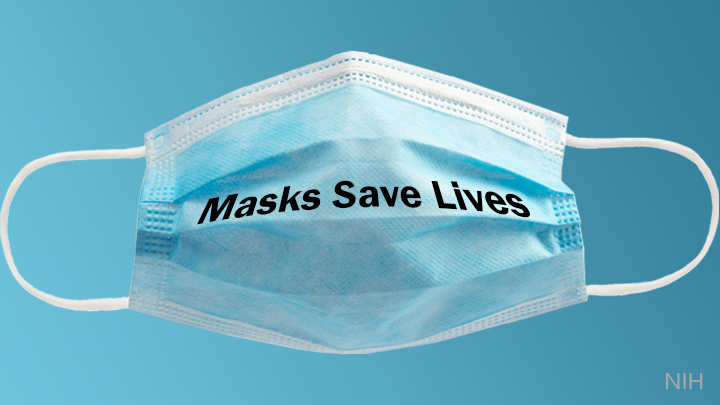masks
Planning Your Holidays During the COVID-19 Pandemic
Posted on by Dr. Francis Collins

With the holiday season fast approaching and coronavirus disease 2019 (COVID-19) surging in most parts of the country, millions of Americans—including me and my family—will break with tradition this year to celebrate in ways that we hope will help to keep us all safe and healthy. Granted, this may present some difficult emotional and logistical challenges, but I’m confident that the American can-do spirit will rise to meet those challenges.
I also recognize that this will be hard for many of us. Celebrating holidays alone or with your immediate household members can sound rather dreary. After all, who wants to roast and carve a turkey for just a few people? But, if you look at it another way, the pandemic does offer opportunities to make this holiday a season to remember in new and different ways. Here are a couple of ideas that you may want to consider:
Send Gifts. Although COVID-19 has changed our lives in many ways, sending cards or gifts remains a relatively easy way to let loved ones know that you’re thinking of them. Who wouldn’t want to receive some home-baked goodies, a basket of fresh fruit, or a festive wreath? If you enjoy knitting, candle making, or other ways of crafting gifts for the holidays, now’s the time to start planning for Thanksgiving through the New Year.
Make Videos. When I’m visiting family, there is often music involved—with guitar, piano, and maybe some singing. But, this year, I’ll have to be content with video recording a few songs and sending them to others by text or email. Come to think of it, the kids and the grandkids might enjoy these songs just as much—or even more—if they can watch them at a time and place that works best for them. (On the other hand, some of them might roll their eyes and decide not to open that video file!) If you don’t play a guitar or like to sing, you can still make your own holiday-themed videos. Maybe share a dance routine, a demonstration of athletic skill, or even some stand-up comedy. The key is to have fun and let your imagination run free.
Share a Meal Remotely. Most of our end-of-the-year holidays involve the family sitting around a table overflowing with delicious food. With all of the videoconferencing platforms now available, it is easy to set aside a block of time to share a meal and good conversation remotely with friends and family members, whether they live nearby or across the country. Rather than one cook slaving over a hot stove or a certain person monopolizing the dinner table conversation, everyone gets a chance to cook and share their stories via their smartphone, tablet, or laptop. You can compare your culinary creations, swap recipes, and try to remember to leave room for dessert. If you have a tradition of playing games or giving thanks for your many blessings, you can still do many of these activities remotely.
Take an After-Dinner Walk. Due to the physical demands and psychological impacts of the COVID-19 pandemic, it’s been difficult for many of us to stay physically active. The key is making exercise a daily priority, and the holidays are no different. After your holiday meal, go on a virtual group walk through your respective neighborhoods to work off the food. Thanks to your smartphone’s camera, you can share your time outdoors and all of the interesting sights along the way. (Yes, the new playground in the local park looks fantastic, and the neighbors really did just paint their house purple!)
Stay Safe. If you plan to go ahead and join a holiday gathering in person, it’s important to remain vigilant, even when interacting with dear friends and loved ones. The greatest risk for spread of COVID-19 right now is these family gatherings. Remember there are risks associated with travel and with interacting with people who’ve not been tested for the coronavirus prior to the event, especially if they reside in a COVID hot spot—which is almost everywhere these days. Try to keep any family gatherings brief and relatively small, about five people or less. If the weather permits, hold the get-together outdoors.
To protect yourself and your loved ones, both now and over the holidays, please follow these 3 W’s:
• Wear a mask when you are out in public and when you are indoors with people who are not part of your immediate household. The only exception is while eating or drinking!
• Watch your distance, staying at least 6 feet away from people who are not part of your immediate household.
• Wash your hands thoroughly and frequently.
Making all of these adjustments is a lot to consider when you’re trying to have a good time and there are children and older adults in the mix. That’s why I and my wife Diane decided the best plan for us this holiday season is to stay home in Maryland and forgo our traditional trips to family in Michigan and North Carolina. Not only did we want to reduce the risk of possibly contracting COVID-19 from—or transmitting it to—our faraway loved ones, we want to do everything we can to protect our local friends and co-workers from the coronavirus.
While this holiday season is likely to be memorable in ways that we never could have imagined, I’m confident that, thanks to the rapid advances being made by medical research, we ultimately will get the COVID-19 pandemic under control so we can once again give everyone we love a big hug in person. Until then, please stay safe. Wishing each of you a wonderful and healthful holiday season, starting with a Happy Thanksgiving!
Links:
Coronavirus (COVID) (NIH)
Your Health: Holiday Celebrations and Small Gatherings (Centers for Disease Control and Prevention, Atlanta)
Your Health: Personal and Social Activities (CDC)
Share this:
- Click to share on LinkedIn (Opens in new window)
- Click to share on Pinterest (Opens in new window)
- Click to share on Tumblr (Opens in new window)
- Click to share on Reddit (Opens in new window)
- Click to share on Telegram (Opens in new window)
- Click to share on WhatsApp (Opens in new window)
- Click to print (Opens in new window)
Posted In: Generic
Tags: biomedical research, coronavirus, COVID-19, COVID-19 prevention, face coverings, family, food, handwashing, holiday season, holidays, mask wearing, masks, pandemic, SARS-CoV-2, social distancing, Thanksgiving, Three W's, travel
Masks Save Lives
Posted on by Dr. Francis Collins

Reminding others that “masks save lives” isn’t just sound advice. It’s a scientific fact that wearing one in public can help to slow the spread of SARS-CoV-2, the virus responsible for the coronavirus disease 2019 (COVID-19) pandemic.
I’m very careful to wear a mask outside my home whenever I’m out and about. I do it not necessarily to protect myself, but to protect others. If by chance I’ve been exposed to the virus and am currently incubating it, I wouldn’t want to spread it to other people. And any of us could be an unknowing superspreader. We owe it to everyone we encounter, especially those who are more vulnerable, to protect them. As my NIH colleague Tony Fauci recently demonstrated, it’s possible to wear your mask even while you’re outside exercising.
But there are still skeptics around. So, just how much does a facial covering protect those around you? Quite a bit, according to researchers who created a sophisticated mathematical model to take a more detailed look [1]. Their model shows that even if a community universally adopted a crude cloth covering that’s far less than 100 percent protective against the virus, this measure alone could significantly help to reduce deaths.
These findings, funded partly by NIH, were published recently in Nature Communications. They come from Colin Worby, Broad Institute of MIT and Harvard, Cambridge, MA, and Hsiao-Han Chang, National Tsing Hua University, Taiwan.
The researchers noted several months ago that recommendations on wearing a mask varied across the United States and around the world. To help guide policymakers, the researchers simulated outbreaks in a closed, randomly interacting population in which the supply and effectiveness of crude cloth or disposable, medical-grade masks varied.
Under different outbreak scenarios and mask usages, the researchers calculated the total numbers of expected SARS-CoV-2 infections and deaths from COVID-19. Not surprisingly, they found that the total number of deaths and infections declined as the availability and effectiveness of face masks increased.
The researchers’ model primarily considered the distribution of medical-grade, surgical masks. But because such masks are currently available in limited supply, they must be prioritized for use by health care workers and others at high risk. The researchers go on to note that the World Health Organization and others now recommend wearing homemade face coverings in public, especially in places where the virus is spreading. While it’s true the ability of these face coverings to contain the virus is more limited than medical-grade masks, they can help and will lead to many fewer deaths.
Another recent paper also suggests that while wearing a mask is primarily intended to prevent the wearer from infecting others, it may also help lower the dose, or inoculum, of SARS-CoV-2 that the wearer might receive from others, resulting in milder or asymptomatic infections [2]. If correct, that’s another great reason to wear a mask.
Already, more than 175,000 people in the United States have died from COVID-19. The latest estimates [3] from the Institute for Health Metrics and Evaluation (IHME) at the University of Washington’s School of Medicine, Seattle, predict that the COVID-19 death toll in the U.S. may reach nearly 300,000 by December 1.
But that doesn’t have to happen. As this new study shows, face coverings—even those that are far from perfect—really can and do save lives. In fact, IHME data also show that consistent mask-wearing—starting today—could save close to 70,000 lives in the months to come. Saving those lives is up to all of us. Don’t leave home without your mask.
References:
[1] Face mask use in the general population and optimal resource allocation during the COVID-19 pandemic. Worby CJ, Chang HH. Nat Commun. 2020 Aug 13;11(1):4049.
[2] Masks Do More Than Protect Others During COVID-19: Reducing the Inoculum of SARS-CoV-2 to Protect the Wearer. Gandhi M, Beyrer C, Goosby E. J Gen Intern Med. 2020 Jul 31.
[3] New IHME COVID-19 forecasts see nearly 300,000 deaths by December 1. Institute for Health Metrics and Evaluation. August 6, 2020.
Links:
Coronavirus (COVID-19) (NIH)
Colin Worby (Broad Institute of MIT and Harvard, Cambridge, MA)
Hsiao-Han Chang (National Tsing Hua University, Taiwan)
NIH Support: National Institute of Allergy and Infectious Diseases
Share this:
- Click to share on LinkedIn (Opens in new window)
- Click to share on Pinterest (Opens in new window)
- Click to share on Tumblr (Opens in new window)
- Click to share on Reddit (Opens in new window)
- Click to share on Telegram (Opens in new window)
- Click to share on WhatsApp (Opens in new window)
- Click to print (Opens in new window)
Posted In: News
Tags: cloth mask, coronavirus, COVID-19, COVID-19 deaths, COVID-19 infections, COVID-19 prevention, disease transmission, face mask, IHME, inoculum, Institute for Health Metrics and Evaluation, masks, novel coronavirus, pandemic, prevention, SARS-CoV-2, superspreader, surgical-grade mask, transmission dynamics, viral load, viral spread, World Health Organization
